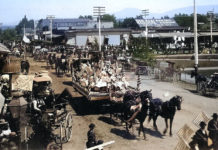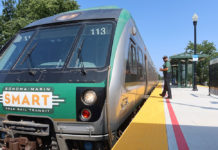Council holding public hearing for water rate increases on Wednesday, Nov. 11
This Wednesday, Nov. 11, the Cloverdale City Council’s lone new agenda item is a costly one to Cloverdale residents — a proposed hike in the city’s water and sewage rates. The increases in both water and wastewater rates — which start with a 13% water increase and 17% wastewater increase on Jan. 1, with the same increase happening on July 1, 2021 and on each subsequent July 1 through 2024 — is something that city officials say is needed to help start capital improvement projects related to the city’s water and wastewater systems. In the past, the cost of such projects haven’t been factored into the city’s rates.
Wednesday’s meeting will have a public hearing for the rate increase. The meeting starts at 6 p.m. and is being held virtually due to COVID-19. To view the agenda, click here.
In previous years, the city’s rate increases have been at smaller increments of around 3%. However, the city’s most recent water rate study recommends increased rates, as well as a back-to-back increase on Jan. 1, 2021 and July 1, 2021, which is unusual compared to the city’s regular July 1 water rate increase schedule.
In an October interview with the Reveille, City Manager David Kelley said that the reason for the January/July increase is that the city was unable to implement an increase in 2020, since it was in the middle of having the water rate study done. The city’s previous rate study, conducted in 2016, only outlined water rates through July 2019.
“Since the previous rate study, one of the things that we’ve undertaken … is a comprehensive review of our capital improvement project needs. The last time the city did a capital improvement program where we looked at all of our capital improvement needs — city facilities, building, projects needed for the water enterprise, projects needed for the wastewater enterprise, major street projects, major airport projects and major drainage projects — (was in 2010). With the help of an engineering consultant we developed a comprehensive capital improvement program,” Kelley said.
In those 10 years, since the last capital improvement program, the cost of improvement projects has increased.
“What’s so critically different this time, versus the previous rate study, is that we’ve started including the cost of those capital improvement projects in the rates,” he said. “That is really, in my opinion, what’s driving the projected rate increases.”
According to its 2020 Water and Wastewater Rate Study, the city has outlined millions of dollars of work to be done on its water and wastewater systems beginning in Fiscal Year 2023. The capital improvements to the water system, pieced out as “mandate,” “necessary” and “desirable” include seven mandated improvements, such as well replacement or rehabilitation and reservoir work, 13 necessary improvement projects such as a new well and water main replacements and five desirable improvements.
Called out in the agenda item for the public hearing on water rates is the $1.27 million rehabilitation of the Cherry Creek Reservoir and the $1.587 million rehabilitation of the Ritter Reservoir.
The largest price tag assigned to the city’s wastewater system is sewer line replacement, which is predicted to cost $9.183 million between Fiscal Year 2023-24 and Fiscal Year 2030-31.
“What happens, unfortunately, is as you delay putting those costs in and paying for those projects, you’re just kicking the can down the road. If you pay for it now, you start setting aside money that helps you pay for it in the future, versus ‘I’m going to wait another year before I start collecting revenue to pay for these projects,’” Kelley said. “In order to afford paying for the projects, you need to collect more.
The cost of waiting to gather funding
What’s critical about incorporating the cost of improvement projects into water and wastewater rates, Kelley said, is trying to address years of deferred maintenance, brought on by the Great Recession as well as reduced staff and revenue.
“A lot of projects got deferred,” Kelley said. “Unfortunately, you can only defer some of these projects for so long before they in essence become critical. If we don’t do this, if we don’t start building into our rates the cost for these projects, it could put us in a detrimental position relative to funding some of these improvements.”
The capital improvement plan for the projects is without a lot of fluff, he said, and the city tried to get rid of any projects that may be truly discretionary, keeping only those that are highly-needed.
“These improvements, there’s very little discretion. These are critical upgrades that just become a matter of timing that you need to get it done and, if you don’t, you can have critical failures that impact your ability to provide either water or wastewater services,” Kelley said.
“The way I look at it is through the lens of, it’s an investment in your community and to ensure that we can continue to provide high-quality wastewater and water services, and make sure it’s done in a manner that is as fair as can be to our community,” Kelley said.
Community members respond: Bad timing and too steep of an increase
According to Wednesday’s council agenda packet, as of Nov. 5 the city received 894 pages of letters contesting the proposed water and wastewater rate changes — the final number of letters opposing the change will be reported out following the Nov. 11 public hearing.
Letters submitted in protest of the rate increases point out how the proposed rates may impact people with lower income, or those who are living on a fixed income and are already having to balance rising cost of living with their income. At least one letter-writer suggested that instead of increasing rates substantially, the city seek a temporary local sales tax to help raise funds for its deferred maintenance. Another community member wrote in expressing their frustration that the city has waited too long to tackle the deferred maintenance, therefore resulting in a higher proposed rate increase. Numerous letters also cite the current pandemic, return to an economic recession and sustained high unemployment rates as reasons for opposing the rate increases, or pushing them off until a sense of normalcy is restored.
According to the public hearing, “If written protests against the proposed water and/or wastewater rates are received for a majority of the parcels subject to the proposed rates, the city will not impose the proposed rates for the utility service(s) receiving the majority protest. If written protests against the proposed increases to the water and/or wastewater rates are not presented by a majority of the parcels subject to the proposed rates, the city will be authorized to adopt the proposed rates.”
At the meeting, city council members can decide to adopt water rate increases that are equal to or less than the ones proposed in the public hearing document.









